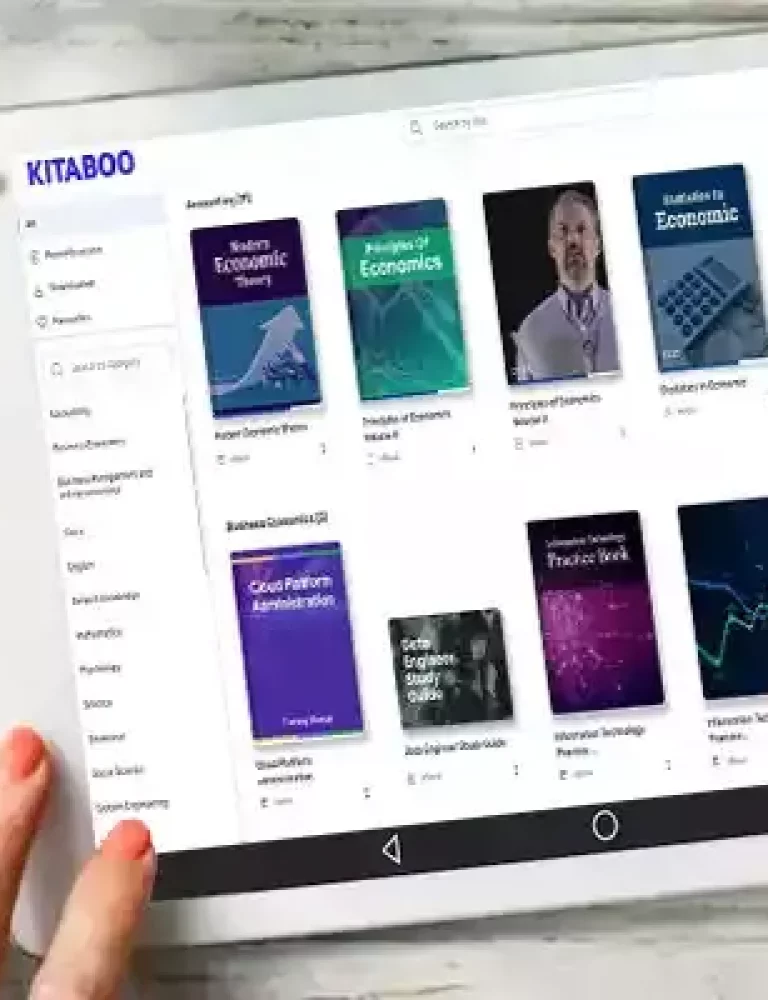Step into the future of storytelling and education! Picture this: by 2027, the eBooks market worldwide is set to boom, generating a staggering revenue of $15.33 billion.
As an educator, publisher, or content creator, riding this digital wave isn’t just smart—it’s essential. Today, we’re diving deep into the world of crafting digital books that inform, captivate and enchant.
From clever design hacks to interactive marvels, we’re spilling the secrets that’ll make your digital creations shine brighter than ever.
Get ready to transform your content into an immersive journey that keeps readers hooked from start to finish. So, grab your digital pen, and let’s unleash the magic of captivating digital books together!
Table of Contents:
II. How to Make a Digital Book that Captivates?
- Choose Engaging Visuals
- Utilize Interactive Elements
- Optimize for Mobile Devices
- Craft Compelling Narratives
- Offer Multimedia Experiences
- Encourage Reader Interaction
- Implement Personalization Features
- Ensure Accessibility for All Readers
- Promote Continuous Learning and Updates
III. Wrapping Up!
What are Digital Books?
Digital books are modern marvels, seamlessly blending text, images, and interactive elements. They’re dynamic, offering features like multimedia integration, annotations, and search functionality.
Digital books offer unparalleled benefits—they’re accessible anytime, anywhere, on any device. They engage learners with interactive quizzes, videos, and simulations, fostering deeper comprehension and retention.
Imagine creating textbooks that come alive with animations and audio explanations, making learning an enjoyable experience.
KITABOO, a leading digital textbook platform, empowers you to bring your vision to life effortlessly. With KITABOO, you can design, format, and publish digital books with ease without the need for extensive technical know-how.
Connect directly with your audience, evolve your content seamlessly, and stay ahead with the latest features and technologies—all with KITABOO by your side.
How to Make a Digital Book that Captivates?
In the digital age, mastering the art of crafting captivating digital books is key to engaging readers and staying ahead.
Let’s explore the top tips and tricks to make digital book experiences that leave a lasting impact in 2024.
1. Choose Engaging Visuals
Visual elements play a crucial role in capturing readers’ attention and enhancing comprehension. Incorporate eye-catching images, illustrations, and graphics that complement your content and resonate with your audience’s preferences and interests.
Vibrant colors, striking imagery, and thoughtful design choices can evoke emotions and create memorable reading experiences. Additionally, consider the placement and layout of visuals to ensure a balanced and visually appealing presentation.
Incorporating diverse visuals throughout your digital book keeps readers visually stimulated and encourages them to stay engaged with your content.
2. Utilize Interactive Elements
Interactive features add depth and interactivity to your digital book, transforming passive reading into an engaging experience. Incorporate interactive elements such as quizzes, polls, interactive infographics, and clickable graphics to encourage reader participation and active learning.
These interactive features reinforce key concepts and provide immediate feedback, enhancing comprehension and retention. Furthermore, consider incorporating gamification elements such as badges, rewards, and progress tracking to motivate readers and make learning more enjoyable.
By integrating interactive elements strategically throughout your digital book, you can create a dynamic reading experience that keeps readers coming back for more.
3. Optimize for Mobile Devices
With an increasing number of readers accessing content on mobile devices, optimizing your digital book for mobile platforms is essential. Ensure that your book’s layout, formatting, and navigation are responsive and user-friendly across various screen sizes and resolutions.
Simplify complex layouts, minimize scrolling, and prioritize readability to provide a seamless reading experience on smartphones and tablets. Additionally, leverage mobile-specific features such as touch gestures, swipe navigation, and offline access to enhance usability and convenience for mobile users.
By prioritizing mobile optimization, you can reach a wider audience and make your digital book accessible to readers on the go.
4. Craft Compelling Narratives
At the heart of every captivating digital book lies a compelling narrative that resonates with readers on an emotional level. Whether you’re creating fiction or non-fiction content, focus on crafting engaging stories with well-developed characters, immersive settings, and gripping plot twists.
Use descriptive language, vivid imagery, and sensory details to transport readers into the world of your story. This will keep them hooked from beginning to end.
Consider incorporating multimedia elements such as audio narrations, ambient sounds, and background music to enhance the storytelling experience further. By weaving narratives that evoke curiosity, suspense, and empathy, you can make digital books that leave a lasting impression on your readers.
5. Offer Multimedia Experiences
Multimedia content adds depth and richness to your digital book, catering to diverse learning styles and preferences.
Enhance your written content with multimedia elements such as audio recordings, video tutorials, interactive simulations, and animated illustrations. These multimedia experiences not only reinforce key concepts but also engage readers’ senses. This facilitates deeper understanding and retention.
Additionally, consider incorporating interactive features such as clickable diagrams, draggable elements, and multimedia hotspots to encourage exploration and hands-on learning. By providing diverse multimedia experiences, you can create engaging digital books that appeal to a wide range of readers.
Guide:
How to Build an eBook Store
6. Encourage Reader Interaction
Foster a sense of collaboration among your readers by incorporating interactive features that facilitate communication and engagement. Integrate discussion forums, comment sections, and social sharing buttons to encourage readers to share their thoughts, insights, and questions with each other.
Encourage peer-to-peer interaction and knowledge sharing by highlighting user-generated content, such as reader reviews, comments, and contributions.
Additionally, consider hosting live Q&A sessions, virtual book clubs, and interactive workshops to deepen reader engagement and foster meaningful connections. By creating opportunities for reader interaction, you can transform your digital book into a vibrant and interactive community hub.
7. Implement Personalization Features
Tailor the reading experience to each reader’s preferences, interests, and learning goals by implementing personalization features in your digital book. Offer customizable themes, font sizes, color schemes, and reading preferences to empower readers to customize their reading experience according to their preferences.
Implement bookmarking options, annotations, and highlighting tools to enable readers to annotate and organize content according to their needs. Leverage recommendation algorithms and personalized content suggestions to curate tailored reading lists and recommendations based on each reader’s reading history and preferences.
By providing personalized reading experiences, you can create digital books that feel personalized and relevant to each reader, enhancing engagement and satisfaction.
8. Ensure Accessibility for All Readers
Make your digital book accessible to readers of all abilities by ensuring compliance with accessibility standards and guidelines. Provide alternative text for images, captions for videos, and transcripts for audio content. This makes your digital book accessible to readers with visual or hearing impairments.
Use clear and concise language, and avoid jargon and complex terminology. Provide definitions for unfamiliar terms to enhance readability and comprehension for all readers.
Additionally, ensure compatibility with screen readers, keyboard navigation, and other assistive technologies to accommodate readers with disabilities. By prioritizing accessibility in your digital book design, you can ensure that all readers have equal access to your content, promoting inclusivity and diversity.
9. Promote Continuous Learning and Updates
Create digital books that evolve and adapt over time. Regularly update and expand your content with new information, insights, and resources. Incorporate the latest research findings, industry trends, and technological advancements into your content. This will keep your digital book relevant and up-to-date.
Encourage readers to engage with your digital book beyond the initial reading experience. Provide access to additional resources, supplementary materials, and bonus content.
Foster a culture of lifelong learning and continuous improvement by inviting reader feedback, suggestions, and contributions. This will enhance and enrich your digital book over time.
By promoting continuous learning and updates, you can make digital books that remain valuable and impactful long after their initial publication date.
Wrapping Up!
Congratulations, you’re now equipped with the tools and strategies to create digital books that captivate and inspire your audience in 2024.
And if you’re looking for a platform to help you bring your digital book vision to life, consider KITABOO. With its user-friendly features and comprehensive capabilities, KITABOO empowers you to create, publish, distribute, and manage your digital book library with ease.
Take your digital publishing journey to the next level with KITABOO today! Connect with us now!
Discover How An Ebook Conversion, Publishing & Distribution Platform Can Help You
Kitaboo is a cloud-based content platform to create-publish & securely distribute interactive mobile-ready ebooks.
You May Also Like








